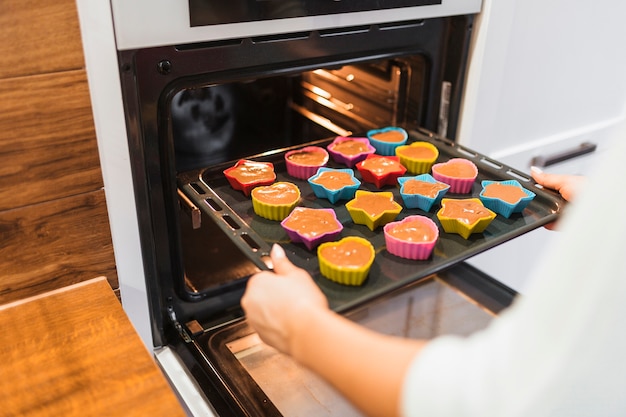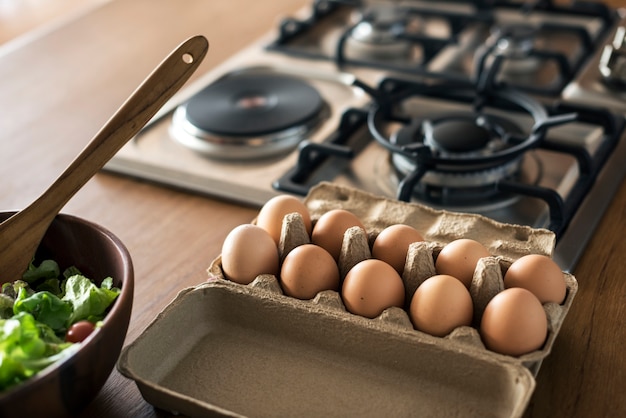We've all been there: mornings where time seems to slip through our fingers, leaving us scrambling for a quick breakfast. And in those moments, nothing beats the simplicity and speed of a microwaved egg. But let's be honest, it can be a bit of a gamble. Sometimes, you end up with a perfectly runny yolk, and other times, you're left with a rubbery, overcooked mess. It's a bit like a culinary roulette wheel, isn't it?
Fear not, fellow breakfast enthusiasts! After years of trial and error, I've finally cracked the code to consistently perfect microwave eggs. Whether you prefer the silky smooth elegance of a soft-boiled egg, the satisfying firmness of a medium-boiled egg, or the sturdy reliability of a hard-boiled egg, I'm going to guide you through the process, step by step.
So, grab your favourite mug and get ready to elevate your microwave egg game. We're going on a culinary adventure, one perfectly cooked egg at a time.
(Part 1) Microwave Egg Basics: Laying the Foundation for Your Perfect Egg

1. The Freshness Factor: Starting with a Good Egg
Before we even think about microwaving, let's start with the foundation of a good egg: freshness. A fresher egg will cook more evenly, resulting in a smoother texture and a less rubbery consistency. Older eggs, with their larger air pockets, cook a bit faster, so you might need to adjust your cooking time accordingly.
Here's a simple way to test the freshness of an egg: fill a bowl with cold water and gently place the egg inside. If the egg sinks to the bottom and lies flat, it's a brand new baby! If it tilts upwards but stays submerged, it's still good, but a bit more mature. And if it floats, it's definitely had its day and best left for other culinary adventures.
2. Choosing the Right Microwave-Safe Container: A Stable Home for Your Egg
The container you choose can make a world of difference. It needs to be large enough to comfortably accommodate your egg, allowing it to move freely and cook evenly. The material is important too. Glass bowls or mugs are often the best choice because they distribute heat evenly and are more durable than plastic.
Remember, a lid or cover is your friend. It helps prevent splattering and keeps the moisture in, resulting in a more tender and moist egg. Think of it as a cosy little incubator for your perfect egg.
3. The Power of Steam: Adding a Splash of Water
This is a crucial step in preventing an exploding egg situation. Adding a tablespoon or two of water to the container before adding the egg creates steam. This steam acts as a gentle conductor, helping the egg to cook more evenly and preventing it from drying out. It's like a tiny steam bath for your egg, resulting in a more delicate and delicious outcome.
4. Piercing the Egg: A Safety Precaution
I learned this the hard way. Once, in a moment of frantic breakfast-making, I forgot to pierce the egg before microwaving it. Let's just say, it was a messy affair.
By poking a small hole in the top of the egg with a toothpick or pin, you release any air pressure that might build up during cooking. This simple step can significantly reduce the risk of an egg explosion and save you from a sticky clean-up situation.
(Part 2) microwave egg cooking Times: A Comprehensive Guide to Different Consistencies

Now for the magic numbers, the cooking times! But remember, just like every microwave is unique, so are your eggs. Microwave wattage can vary, so it's always best to start with a shorter cooking time and gradually increase it until you achieve the consistency you crave.
1. soft boiled eggs: The Delicate Delight of a Runny Yolk
Ah, the soft-boiled egg. It's a breakfast classic, perfect for a quick and comforting start to the day. The runny yolk is a flavour sensation, a delightful contrast to the firm white.
To achieve that perfect soft-boiled egg, follow these steps:
- Place a single egg in a microwave-safe bowl or mug with a tablespoon of water.
- Pierce the top of the egg with a toothpick or pin.
- Microwave on high for 45-50 seconds.
You'll end up with a soft-boiled egg with a runny yolk and a slightly firm white. It's a delicate dance of textures, a subtle symphony of flavours.
2. medium-boiled eggs: Finding the Perfect Balance of Firm and Creamy
For those who prefer a slightly firmer yolk but still retain a touch of creaminess, a medium-boiled egg is the golden middle ground. It's a versatile choice, equally delicious in salads, sandwiches, or as a solo snack.
Here's how to get it just right:
- Follow the same steps as for the soft-boiled egg.
- Increase the microwave time to 55-60 seconds.
You'll notice that the yolk will be slightly more set but still have a bit of a jiggle to it, and the white will be completely firm. It's a delicious balance of textures, a satisfying middle ground between runny and solid.
3. hard boiled eggs: A Culinary Workhorse for Salads and deviled eggs
hard-boiled eggs are a kitchen essential. From salads and sandwiches to deviled eggs and countless other recipes, their versatility is unmatched. And yes, you can achieve that perfect hard-boiled egg in your microwave!
My method involves a slightly longer cooking time:
- Place a single egg in a microwave-safe bowl or mug with a tablespoon of water.
- Pierce the top of the egg with a toothpick or pin.
- Microwave on high for 1 minute to 1 minute and 15 seconds.
The result? A hard-boiled egg with a completely firm yolk and white. A solid, dependable choice for all your culinary needs. For added peace of mind, you can even add a pinch of salt to the water to prevent the egg from cracking during cooking, though it's not strictly necessary.
(Part 3) Tips and Tricks: Elevating Your Microwave Egg Game

Now that you have the foundational knowledge, let's dive into some tips and tricks to enhance your microwave egg experience.
1. Patience is Key: Resist the Urge to Peek
It's tempting to constantly check on your egg, but resist the urge to open the microwave door during cooking. This can disrupt the heat distribution and lead to uneven cooking. Trust the process, and let your egg cook undisturbed for the recommended time. Patience, my friend, will reward you with a more consistently cooked egg.
2. The Art of Time Adjustment: Finding Your Microwave's Sweet Spot
As we've discussed, every microwave is unique. Don't be afraid to adjust the cooking time based on your specific microwave's power. It's always a good idea to start with a shorter cooking time and then increase it gradually, a few seconds at a time, until you achieve the desired consistency. You'll find the perfect sweet spot for your microwave and your egg preferences.
3. Resting: Giving Your Eggs Time to Relax
After cooking, allow your eggs to rest for a few minutes before peeling them. This helps prevent them from breaking and makes peeling easier.
I usually give my eggs a 5-minute rest, but you can adjust this based on your preference. Think of it as a time for your eggs to unwind and prepare for their transformation into a delicious breakfast treat.
(Part 4) Microwave Egg Variations: Stepping Outside the Egg-Shell
Now that you've mastered the basics, let's explore some fun and flavourful variations for your microwave egg adventures!
1. scrambled eggs in a Mug: A Quick and Easy Breakfast Solution
Who needs a pan when you can scramble eggs in a mug? This is a fast and simple breakfast option that's perfect for those mornings when time is of the essence.
Here's how to do it:
- Crack an egg into a microwave-safe mug.
- Add a splash of milk or cream and a pinch of salt and pepper.
- Whisk the mixture together until it's frothy.
- Microwave on high for 30-45 seconds, stirring halfway through.
You'll have fluffy scrambled eggs in no time! A perfect solution for a satisfying and speedy start to your day.
2. egg white Omelets in a Mug: A Lighter and Healthier Option
If you're looking for a lighter, lower-calorie breakfast option, egg white omelets in a mug are a fantastic choice. They're packed with protein and provide a delicious and healthy way to start your day.
Here's how to make them:
- Separate the egg white from the yolk.
- Crack the egg white into a microwave-safe mug.
- Add your favourite fillings, such as chopped vegetables, cheese, or herbs.
- Microwave on high for 30-45 seconds.
Enjoy your protein-packed egg white omelet! A delicious and nutritious way to fuel your morning.
3. Microwave Eggs with Cheese: Adding a Creamy and Indulgent Twist
For a cheesy twist, try adding a slice of cheese to your microwave egg. The cheese will melt beautifully, creating a delicious and comforting breakfast.
Here's how to do it:
- Place a single egg in a microwave-safe bowl or mug with a tablespoon of water.
- Place a slice of cheese on top of the egg.
- Microwave on high for the desired cooking time for your desired egg consistency.
The cheese will melt perfectly as the egg cooks, adding a creamy, cheesy flavour to your breakfast. A simple, yet satisfying way to elevate your morning meal.
4. Microwave Eggs with Spices: A World of Flavour at Your Fingertips
Don't be afraid to get creative with your spices! A sprinkle of paprika, cayenne pepper, or cumin can add a delicious kick to your microwave eggs. Experiment with different spice combinations to find your favorites. You might be surprised at what you discover!
A simple sprinkle of spices can transform your microwave egg into a culinary adventure, a world of flavour waiting to be explored.
(Part 5) Troubleshooting Microwave Egg Cooking: Solving Those Culinary Conundrums
Let's face it, sometimes things don't go exactly according to plan. Even with the best tips and tricks, there are times when your microwave egg might not turn out exactly as you hoped. But don't worry, I've got you covered!
1. The "Eggsplosion": Preventing a Messy Situation
Ah, the dreaded egg explosion. This is usually caused by an egg that wasn't pierced or by using a container that was too small, leading to a buildup of pressure.
The solution? Make sure to pierce the egg before cooking, and use a container that allows for some space around the egg.
Think of it as giving your egg some breathing room, preventing a messy, explosive situation.
2. The "Rubber Egg": Overcooked and Unpalatable
Overcooked eggs can become rubbery and unappealing. This is often a result of cooking them for too long.
The solution? Reduce the cooking time next time. It's always better to err on the side of undercooking, as you can always microwave the egg for a few more seconds if needed.
Think of it as a gentle approach, gradually building up the cooking time until you achieve the desired consistency.
3. The "Unevenly Cooked Egg": Ensuring a Smooth and Consistent Cook
Sometimes, your egg might be cooked unevenly, with one side being more firm than the other. This is often due to uneven heating in the microwave.
The solution? Rotate the egg halfway through the cooking time to ensure even heating.
It's a simple step that can make a world of difference in the consistency of your egg.
4. The "Undercooked Yolk": A Quick Fix for a Soft Yolk
If you're aiming for a hard-boiled egg but the yolk still feels a bit soft, simply microwave it for a few more seconds.
Just be careful not to overcook it, or you'll end up with a rubbery egg.
Think of it as a gentle nudge towards the desired consistency, a few more seconds of heat can make all the difference.
(Part 6) microwave egg recipes: Expanding Your Culinary Horizons
Now that you've mastered the art of the basic microwave egg, it's time to explore some delicious recipes that feature microwave eggs as the star ingredient.
1. Microwave egg salad: A Simple and Delicious Snack or Lunch
This is a quick and easy lunch or snack that's perfect for busy days.
Here's what you'll need:
- 2 hard-boiled eggs, chopped
- 1/4 cup mayonnaise
- 1 tablespoon Dijon mustard
- 1/4 teaspoon salt
- 1/4 teaspoon black pepper
- 1/4 cup chopped celery
- 1/4 cup chopped onion
Instructions:
- In a bowl, combine the chopped hard-boiled eggs, mayonnaise, mustard, salt, and pepper.
- Stir until well combined.
- Fold in the chopped celery and onion.
- Serve on bread, crackers, or lettuce leaves.
2. Microwave Deviled Eggs: A Classic Party Appetizer Made Easy
Deviled eggs are a classic party appetizer, and you can make them in the microwave!
Here's what you'll need:
- 6 hard-boiled eggs
- 1/4 cup mayonnaise
- 1 tablespoon Dijon mustard
- 1/4 teaspoon salt
- 1/4 teaspoon black pepper
- 1/4 teaspoon paprika
Instructions:
- Peel the hard-boiled eggs and cut them in half lengthwise.
- Carefully scoop out the yolks into a bowl.
- Mash the yolks with a fork until smooth.
- Add the mayonnaise, mustard, salt, pepper, and paprika.
- Stir until well combined.
- Spoon the mixture back into the egg whites.
- Sprinkle with additional paprika.
- Serve chilled.
3. Microwave Egg and Ham Breakfast Sandwiches: A Hearty and Satisfying Breakfast
A hearty and satisfying breakfast sandwich that's ready in minutes.
Here's what you'll need:
- 2 english muffins
- 2 slices of ham
- 2 eggs
- 1 tablespoon shredded cheese
Instructions:
- Split the English muffins in half.
- Place the ham slices on the bottom halves of the English muffins.
- Crack an egg into each English muffin half.
- Sprinkle each egg with cheese.
- Microwave on high for 45-60 seconds, until the egg is set and the cheese is melted.
- Serve immediately.
(Part 7) The Science Behind Microwave Egg Cooking: Understanding the Process
You might be wondering, how does a microwave actually cook an egg? Let's delve into the science behind it.
Microwaves work by using electromagnetic radiation to heat food. The water molecules in food absorb the energy from the microwaves and start to vibrate. This vibration creates heat, which cooks the food.
In the case of eggs, the heat from the microwave causes the proteins in the egg white to denature and solidify. This is why the egg white becomes firm when cooked.
The yolk also contains proteins, but it also has a high fat content. This fat helps to slow down the cooking process, which is why the yolk can remain runny or soft even when the white is cooked.
By understanding the science behind microwave egg cooking, you can better control the cooking time and achieve your desired egg consistency.
(Part 8) FAQs: Your Microwave Egg Questions Answered
1. Can I cook multiple eggs at once in the microwave?
Yes, you can, but it's best to cook them in separate containers. This will help ensure that each egg cooks evenly.
2. What if I don't have a microwave-safe container with a lid?
You can still cook eggs in a microwave-safe bowl without a lid, but it's essential to use a smaller container so that the egg doesn't touch the sides. You'll also want to cover the bowl with a piece of plastic wrap to prevent splattering.
3. Can I use a plastic container for microwave egg cooking?
It's generally not recommended to use plastic containers for cooking eggs in the microwave. Plastic can leach chemicals into your food when heated, and some types of plastic aren't microwave-safe. Stick to glass or ceramic containers for the best results.
4. Can I cook eggs in their shells in the microwave?
No, it's not safe to cook eggs in their shells in the microwave. The eggshells can crack and explode, leading to a messy situation.
5. How long do I need to microwave a boiled egg for it to be hard boiled?
For a hard-boiled egg with a completely firm yolk and white, you'll need to microwave it for 1 minute to 1 minute and 15 seconds. However, it's always best to start with a shorter cooking time and increase it gradually until you achieve the desired consistency.
Remember, the key to mastering microwave egg cooking is experimentation. Don't be afraid to try different methods and cooking times to find what works best for you and your microwave. And most importantly, have fun with it!
Everyone is watching

Corn on the Cob: The Ultimate Guide to Perfectly Cooked Ears
Healthy MealsAh, corn on the cob. Just the name evokes images of sunny days, barbecues, and that sweet, juicy flavour that ...

Perfect Pork Roast Oven Cooking Time: A Guide to Delicious Results
Healthy MealsThere's something truly satisfying about a perfectly roasted pork. The aroma alone is enough to make your mout...

Ham Cooking Time: How Long to Bake, Smoke, or Boil a Delicious Ham
Healthy MealsAh, ham. It's a classic, isn't it? A real crowd-pleaser, especially around holidays. And when done right, it'...

Scallops: The Ultimate Guide to Perfect Cooking
Healthy MealsAh, scallops. Those delicate, sweet, and utterly delicious morsels of the sea. They hold a special place in my...

Spaghetti Squash: The Ultimate Guide to Cooking and Serving
Healthy MealsRemember that time you saw spaghetti squash at the supermarket, looking all bumpy and strange, and thought, "W...
